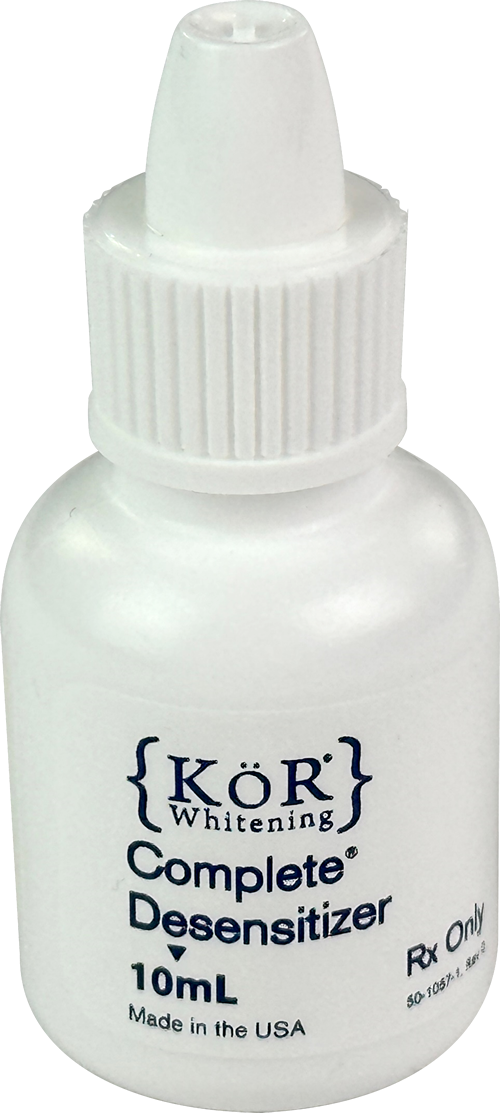 Because every sensitive patient is an emergency!
Because every sensitive patient is an emergency!
KöR Complete Desensitizer is immediately and profoundly effective for any type of dentinal hypersensitivity.
Unlike typical oxalate desensitizing products that simply “clog up” the open orifices of dentinal tubules, KöR Complete reacts with and strongly bonds to hydroxyapatite molecules in tooth structure via a chelation reaction, forming a durable compound of calcium oxalate salt crystals fused to peritubular hydroxyapatite 7-12µ deep within dentinal tubules.
NOTE: KöR Complete Desensitizer is approved to dispense to patients for at-home use. CLICK HERE to see available at-home kits for patient dispensing.
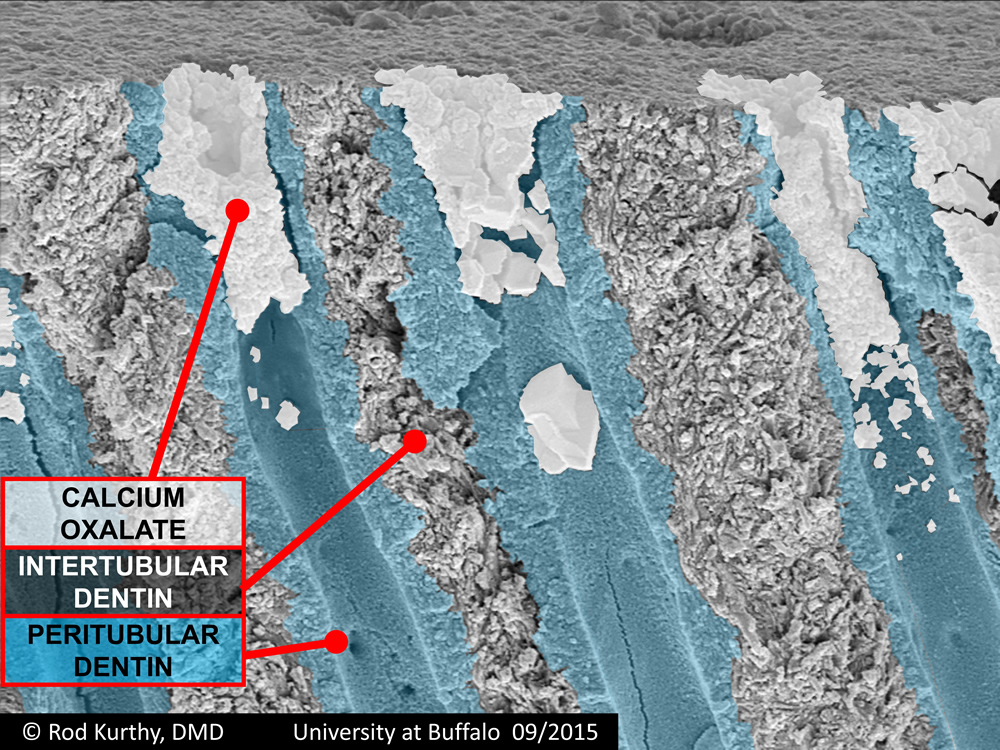
SEM of dentinal tubules closed and sealed with KöR Complete Desensitizer.
SEM by Univ. at Buffalo School of Dental Medicine 09/2015.
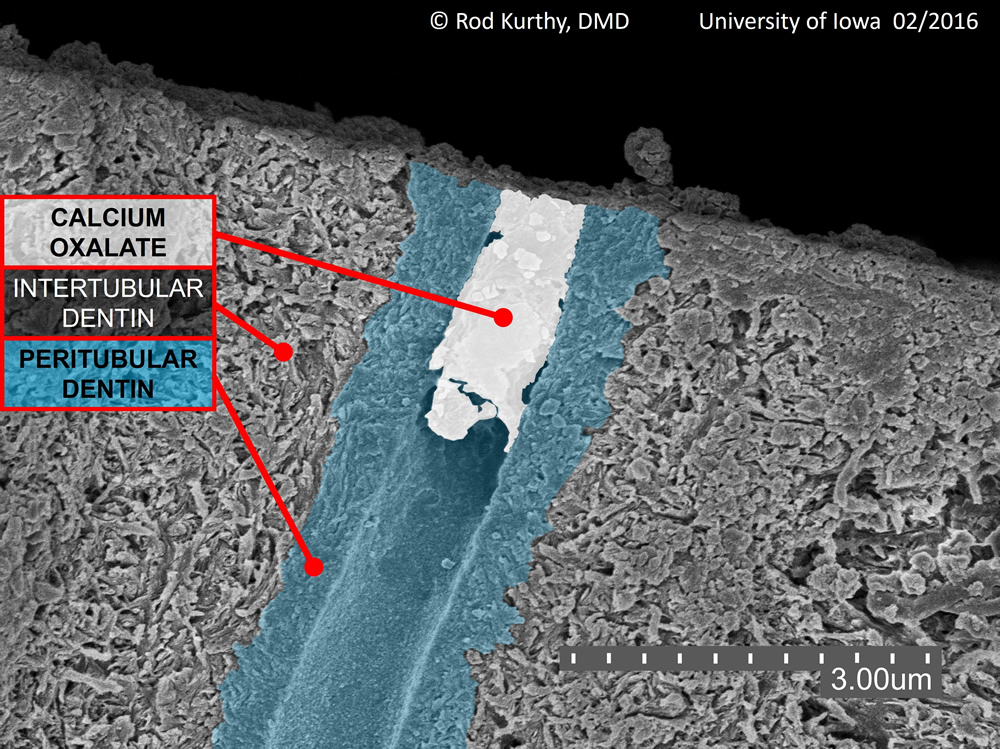
SEM of dentinal tubule closed and sealed with KöR Complete Desensitizer.
SEM by Univ. of Iowa College of Dentistry 02/2016.
KöR® Complete Desensitizer™ has also been shown to bond to and within the natural enamel lamellae (developmental “cracks” through enamel, sometimes extending into dentin).
Just FYI:
If you don’t think bacteria get into and through dentinal tubules into the pulp… think again!
After restorative preparation of teeth, bacteria and bacterial toxins may rapidly penetrate into the pulp through open dentinal tubules – not only creating inflammation, but eventually causing even infection of the pulp. Don’t believe us? Check out the twenty-four scientific references near the bottom of this page.
If you’ve been told that bacteria cannot move through open dentinal tubules, see for yourself in the SEM photos below:
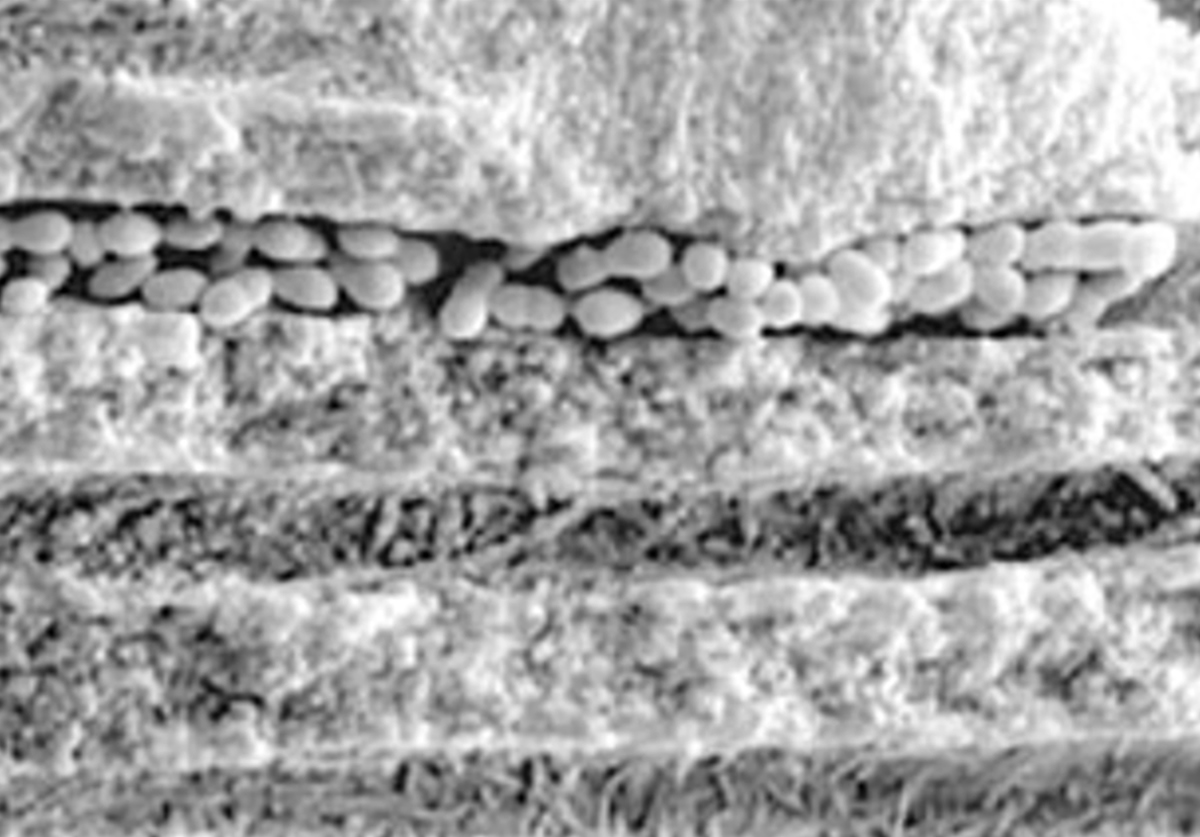
Gurgel-Filho ED, Vivacqua-Gomes N, Gomes BP, Ferraz CC, Zaia AA, Souza-Filho FJ. In vitro evaluation of the effectiveness of the chemomechanical preparation against Enterococcus faecalis after single- or multiple-visit root canal treatment. Braz Oral Res. 2007 Oct-Dec;21(4):308-13.
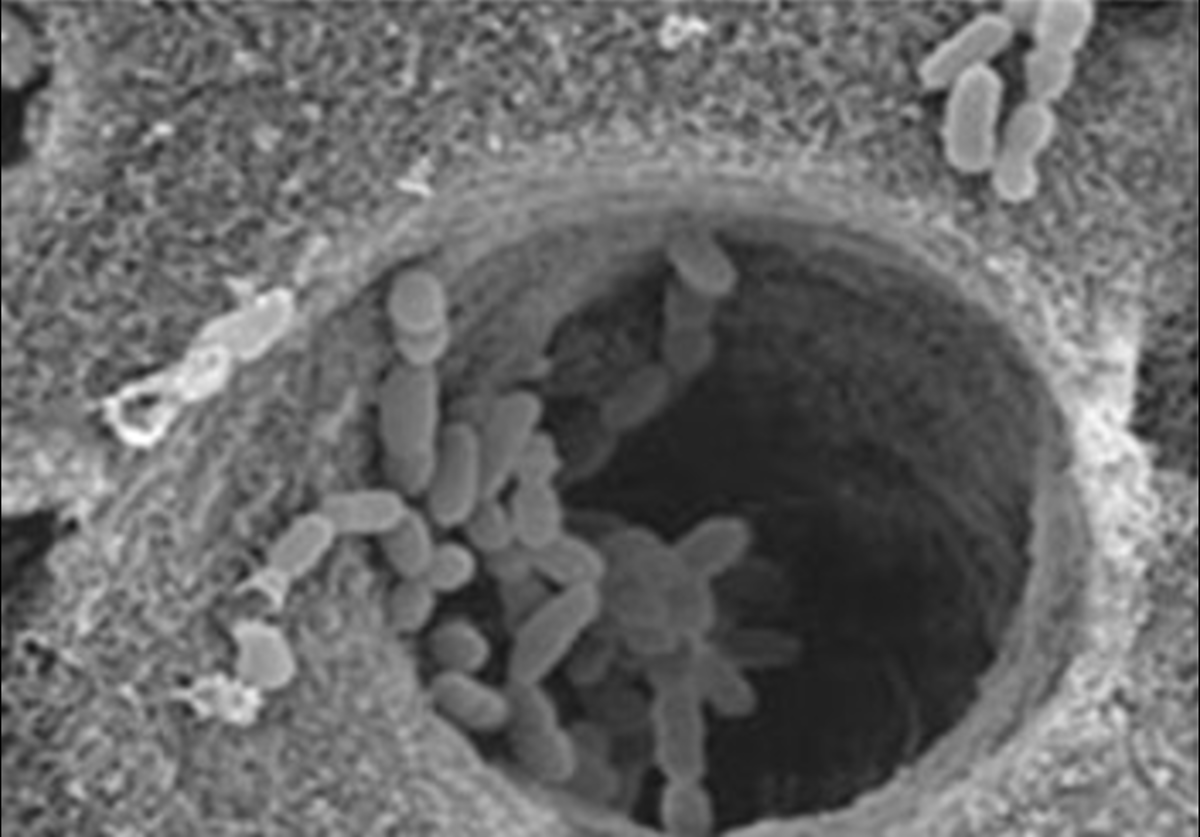
Deutsch AS. Irrigation: When to Use What. Dentistry Today. 2011 June.
KöR Complete™ plugs dentinal tubules instantly to block bacterial penetration, desensitizes without affecting bonding or bond strength, and takes only seconds to apply. Use it on all preps—especially when placing temps—immediately after finishing the preparations.
For patients with generalized sensitivity, dispensing KöR Complete home-use kits is also a major benefit. CLICK HERE to see available at-home kits for patient dispensing.
Uses of KöR Complete™ Desensitizer
KöR® Complete™ Desensitizer has been shown to be a uniquely profound, immediate and durable desensitizer for virtually any clinical requirement, including:
- Treatment of generalized and localized tooth sensitivity
- Treatment of sensitive exposed root surfaces
- Desensitizes during and after hygiene, scaling and root planning procedures
- Treatment of acutely sensitive roots after periodontal surgery
- Does not irritate gingival tissues
- Will not interfere with surgical flap healing
- Prevent tooth sensitivity under temporary/provisional restorations
- Rapidly seals dentinal tubules
- Reduces bacterial contamination of the pulp by sealing freshly cut, wide-open dentinal tubules.
- Cleansing temporary cement residue from the prep prior to final cementation
- Prevent tooth sensitivity under final indirect restorations
- Rapidly seals dentinal tubules
- Reduces bacterial contamination of the pulp by sealing freshly cut, wide-open dentinal tubules.
- Use under direct bonded composite restorations
- Use as a re-wetting agent during bonding procedures
- Under amalgam restorations
- Diagnostic tool to differentiate between reversible and irreversible pulpitis
- If tooth is still sensitive after use of KöR Complete Desensitizer, this indicates a different cause of sensitivity (traumatic occlusion and/or irreversible pulpitis).
- So profoundly effective that FDA approves the above statement.
References:
- Ostro E, Keall CL, Keall HJ et al. Pulpal Response in Monkey Teeth with Controlled Smear Layer Removal. J Dent Res 1985;64 (Abstract No. 426):222.
- Bergenholtz G. Inflammatory response of the dental pulp to bacterial irritation. J Endod. 1981 Mar;7(3):100-4.
- Pashley DH. Dentin: a dynamic substrate–a review. Scanning Microsc. 1989 Mar;3(1):161-74; discussion 174-6.
- Kolker JL, Vargas MA, Armstrong SR, Dawson DV. Effect of desensitizing agents on dentin permeability and dentin tubule occlusion. J Adhes Dent. 2002 Fall;4(3):211-21.
- Love RM, Jenkinson HF. Invasion of dentinal tubules by oral bacteria. Crit Rev Oral Biol Med. 2002;13(2):171-83.
- Olgart L, Brannstrom M, Johnson G. Invasion of bacteria into dentinal tubules. Experiments in vivo and in vitro. Acta Odontol Scand. 1974;32:61–70.
- Perez F, Calas P, de Falguerolles A, Maurette A. Migration of a Streptococcus sanguis strain through the root dentinal tubules. J Endod. 1993;19:297–301.
- Bergenholtz G, Lindhe J. Effect of experimentally induced marginal periodontitis and periodontal scaling on the dental pulp. J Clin Periodontol. 1978;5:59–73.
- Fouad AF. The microbial challenge to pulp regeneration. Adv Dent Res. 2011 Jul;23(3):285-9. doi: 10.1177/0022034511405388.
- NIAZY, HA. The Effect of Three Desensitizing Agents on Dentin Hypersensitivity in Human Subjects Following Routine Crown Preparation. A Thesis: submitted to the Graduate School Faculty of The UAB, in partial fulfillment of the requirements for the degree of Master of Science – Birmingham, AL – 1999
- Farmer JB, Cox CF. Pulp Response Following Treatment of Dentin with Various Sealing Agents. J Dent Res 1990; 69(Abstract No. 1535):300.
- Hahn CL, Best AM, Tew JG. Cytokine induction by Streptococcus mutans and pulpal pathogenesis. Infect Immun. 2000;68:6785–6789.
- Peters LB, Wesselink PR, Moorer WR. Penetration of bacteria in bovine root dentine in vitro. Int Endod J. 2000;33:28–36.
- Love RM. The effect of tissue molecules on bacterial invasion of dentine. Oral Microbiol Immunol. 2002;17:32–37.
- Adriaens PA, Edwards CA, De Boever JA, Loesche WJ. Ultrastructural observations on bacterial invasion in cementum and radicular dentin of periodontally diseased human teeth. J Periodontol. 1988;59:493–503.
- Duran I, Sengun A, Hadimli HH, Ulker M. Evaluation of Antibacterial Effectiveness of Desensitizers against Oral Bacteria. Eur J Dent. 2008 Jan; 2: 43–47.
- Siqueira JF Jr, De Uzeda M, Fonseca ME. A scanning electron microscopic evaluation of in vitro dentinal tubules penetration by selected anaerobic bacteria. J Endod. 1996 Jun;22(6):308-10.
- Pashley E, Comer R, Simpson M. et al. Dentin permeability: Sealing the dentin in crown preparations. Oper Dent.1992;17:113-20.
- Olgart L, Kerezoudis N. Nerve-pulp interactions. Arch Oral Biol. 1994;39:475-545.
- Cox, Charles F, DMD, Professor of Dentistry, Univ. of Alabama. Dentine Sensitivity: A Historical & Scientific Review. 1997.
- Brännström M. Dentin & Pulp in Restorative Dentistry. Castelnuovo (AT). Wolfe Med pubs Ltd.1982:9-19.
- Cagidiaco M, Ferrari M, Garberoglio R, et al. Dentin contamination protection after mechanical preparation for veneering. Am J Dent. 1996;9:57-60.
- Brännström M. Reducing the risk of sensitivity & pulpal complications after placement of crowns & fixed partial dentures. Quint Int.1996; 27:673-678.
- Lilja J, Nordenvall K, Brännström M. Dentin sensitivity, odontoblasts & nerves under desiccated or infected experimental cavities. Swed Dent J.1982;6:93-103.
KöR® Whitening Gallery
Almost any whitening company can show you a few impressive before and after photos. But we have literally hundreds of cases, submitted by doctors like you, showing the phenomenal results you can get with the KöR® Whitening System.


